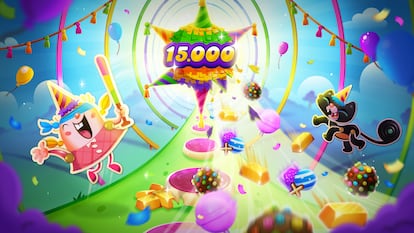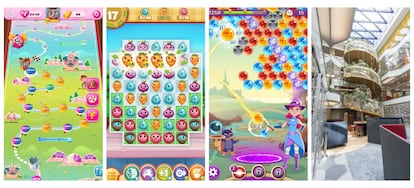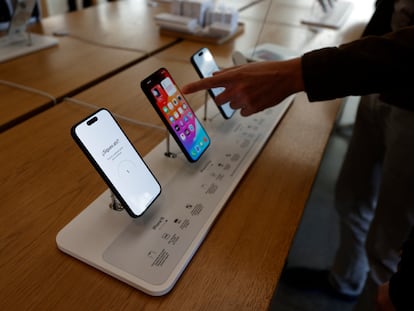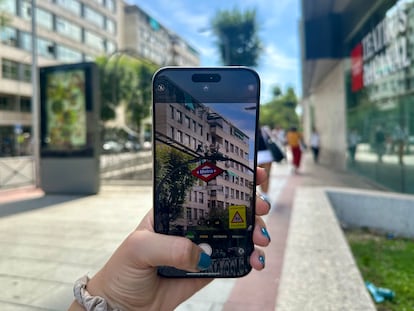The Midas touch: from ‘Candy Crush’ to conquering the world, King studio turns 20
Celebrating the video game developer’s two decades of success, we examine the changes that the mobile game has experienced over the years

If someone were to ask: “what is Candy Crush?” the chances are that they would be told that it is two things at the same time. As a game, it is an addictive match-three puzzle game on a 9x9 board wrapped in a candy store setting. But as a cultural phenomenon, it is is a game with more than 250 million monthly players, 2.7 billion downloads in its ten-year history and the jewel in the crown of King studio, which laid the foundations of casual mobile gaming as a service. With Candy Crush Saga (and other mobile games such as Farm Heroes and Bubble Witch) the studio, which is celebrating its 20th anniversary this year, has the Midas touch when it comes to interactive entertainment and has generated $20 billion (€19.34 billion) in income. “Important things are happening with technology. “Things that we want to apply to King’s games to continue growing,” Tjodolf Sommestad, the president of King, tells EL PAÍS at a meeting that the studio organized in London for its 20th birthday.
In King’s offices, in the heart of the British capital, there is something of a Charlie and the Chocolate Factory atmosphere, an air of a shopping mall at Christmas that continues throughout the year: there are stuffed toys, tchotchkes, and a healthy Nordic camaraderie among its employees. In a colorful, carpeted room, Todd Green, CEO of Candy Crush Saga, shows off something he and the company are especially proud of: the recently unveiled level 15,000 is the highest peak (for now) of a mountain that never stops growing. In addition to letting the press play at that level, what is fascinating is seeing how Green breaks down what really matters about a video game: interactive calligraphy. The secret of Candy Crush lies in the philosophy that the player is always having fun through rapid dexterity and there being no “dead pixels,” in Green’s words. Thousands of hours of programming and thousands of adjustments have gone into making every move satisfying. Therein also lies the key to its addictiveness.
What Green defines as “Addiction,” is based on three keys: the puzzle and the map should be addictive and there needs to be new content. But addiction, without quotes, is something that worries society and companies. The numbers of compulsive consumers are not large if we take into account the huge total of the game’s audience, but Candy Crush is engaging. Therein lies a large part of a success that, however, the game itself limits with built-in alerts to tell players if they are spending too much time playing, according to Sommestad, the studio’s president. Remember that part of the success of the game and the company are its partnerships with commercial products, such as its collaboration with the Jonas Brothers or more recently with the Barbie movie.

King’s story is that of the most gifted student among the pioneers of casual digital entertainment. It began on the Midasplayer website, a mini-game website, where many of the ideas that the company continues to apply today were tested. In 2007, Facebook landed like a meteorite and starting in 2009, Mark Zuckerberg’s social network (which had squeezed its competition out by then) changed the rules of the game by introducing mini-games onto its platform. King partnered with Facebook, where it was extremely successful with games like Bubble Witch, and when smartphones arrived, the company was more than prepared to offer easy-to-consume games to the millions of new players who could suddenly connect to the digital world. The rest is history, and along the way King’s games have been downloaded five billion times. It’s as if almost every person on the planet has played one of their games.
The most fashionable words of the 2023 resonate in the hallways, in the offices, and in the interviews: Artificial Intelligence. King is betting big on it. Steve Collins, King’s Chief Technology Officer believes it is clearly where the company’s future lies. Today King has about 50 people working entirely with AI. Why use AI in King’s games? After reflecting on AI in video games, from PacMan to Black and White or the zombie game of Left 4 Dead, Collins is succinct about it: “To optimize content. To optimize the gaming experience,” he says before remembering AlphaGo, the program that in October 2015 became the first Go machine to win against a professional player. “AlphaGo is better than players, but we don’t want that: we want our AIs to be just like them. “This is how we learn,” says Collins, “to make the game more important to the player in an organic way.”
King is a titan that was acquired in 2017 by Activision — which spent $5.9 billion (€5.5 billion) — and in 2022 became part of Microsoft when it in turn bought Activision for $68 billion (€63.5 billion), in a decision that was blocked at first (and just recently provisionally approved) by the British regulator, ratified by the European Union, and is still pending trial in the United States. The business package may have changed, but the philosophy remains the same. These days King has circulated a fact that is as curious as it is paradigmatic: if the distance of all the movements made by our thumb in Candy Crush over the last five years were added up, it would travel around the world almost seven times. If we take into account that each of those swipes measures just over a centimetre (half an inch), that gives a measure of the global fever for a game (and a studio) that seems to have come straight from Roal Dahl’s imagination. Only this time the chocolate factory is still running smoothly and Willy Wonka doesn’t even remotely have a successor on the horizon.
Sign up for our weekly newsletter to get more English-language news coverage from EL PAÍS USA Edition
Tu suscripción se está usando en otro dispositivo
¿Quieres añadir otro usuario a tu suscripción?
Si continúas leyendo en este dispositivo, no se podrá leer en el otro.
FlechaTu suscripción se está usando en otro dispositivo y solo puedes acceder a EL PAÍS desde un dispositivo a la vez.
Si quieres compartir tu cuenta, cambia tu suscripción a la modalidad Premium, así podrás añadir otro usuario. Cada uno accederá con su propia cuenta de email, lo que os permitirá personalizar vuestra experiencia en EL PAÍS.
¿Tienes una suscripción de empresa? Accede aquí para contratar más cuentas.
En el caso de no saber quién está usando tu cuenta, te recomendamos cambiar tu contraseña aquí.
Si decides continuar compartiendo tu cuenta, este mensaje se mostrará en tu dispositivo y en el de la otra persona que está usando tu cuenta de forma indefinida, afectando a tu experiencia de lectura. Puedes consultar aquí los términos y condiciones de la suscripción digital.
More information
Últimas noticias
All the effects of gentrification in one corner of Mexico’s Colonia Roma
Palestinian reporter Youmna El Sayed: ‘My family told me I had to choose between being a journalist or a mother’
The new language of the workplace: Knowing how to ask AI questions is more important than using it
Christmas loses its festive spirit: ICE fears cast shadow over religious celebrations
Most viewed
- Families demand repatriation of bodies of Colombians who died in Ukraine: ‘This war is a slaughterhouse for foreigners’
- The low-cost creative revolution: How technology is making art accessible to everyone
- Liset Menéndez de la Prida, neuroscientist: ‘It’s not normal to constantly seek pleasure; it’s important to be bored, to be calm’
- Christian Louboutin: ‘Young people don’t want to be like their parents. And if their parents wear sneakers, they’re going to look for something else’
- ‘El Limones’ and the growing union disguise of Mexican organized crime











































